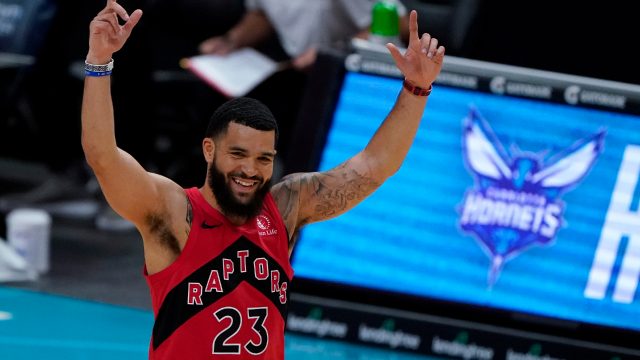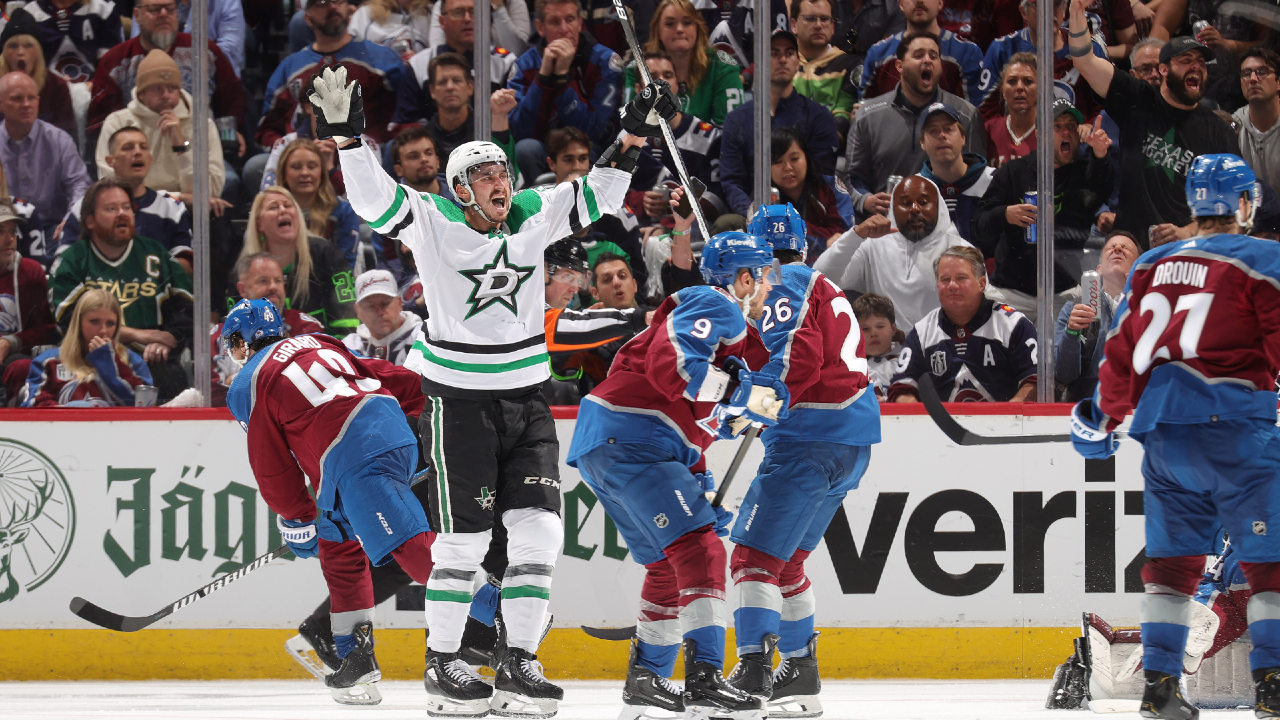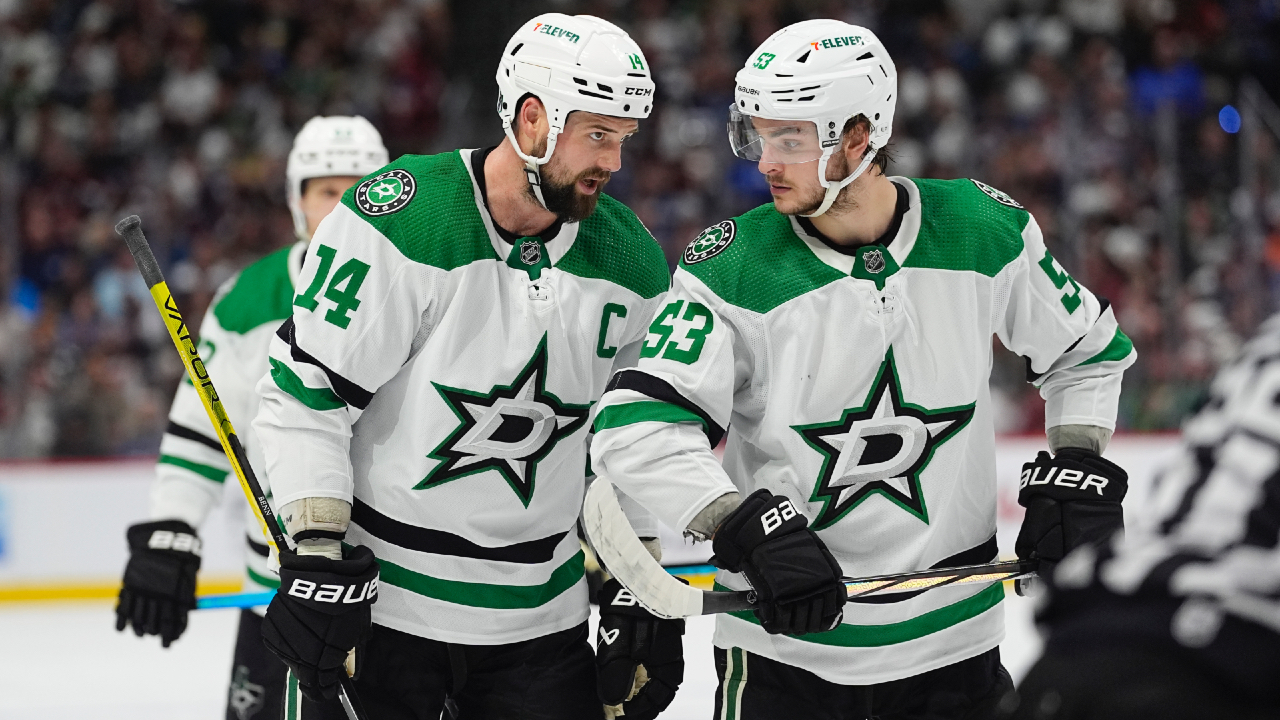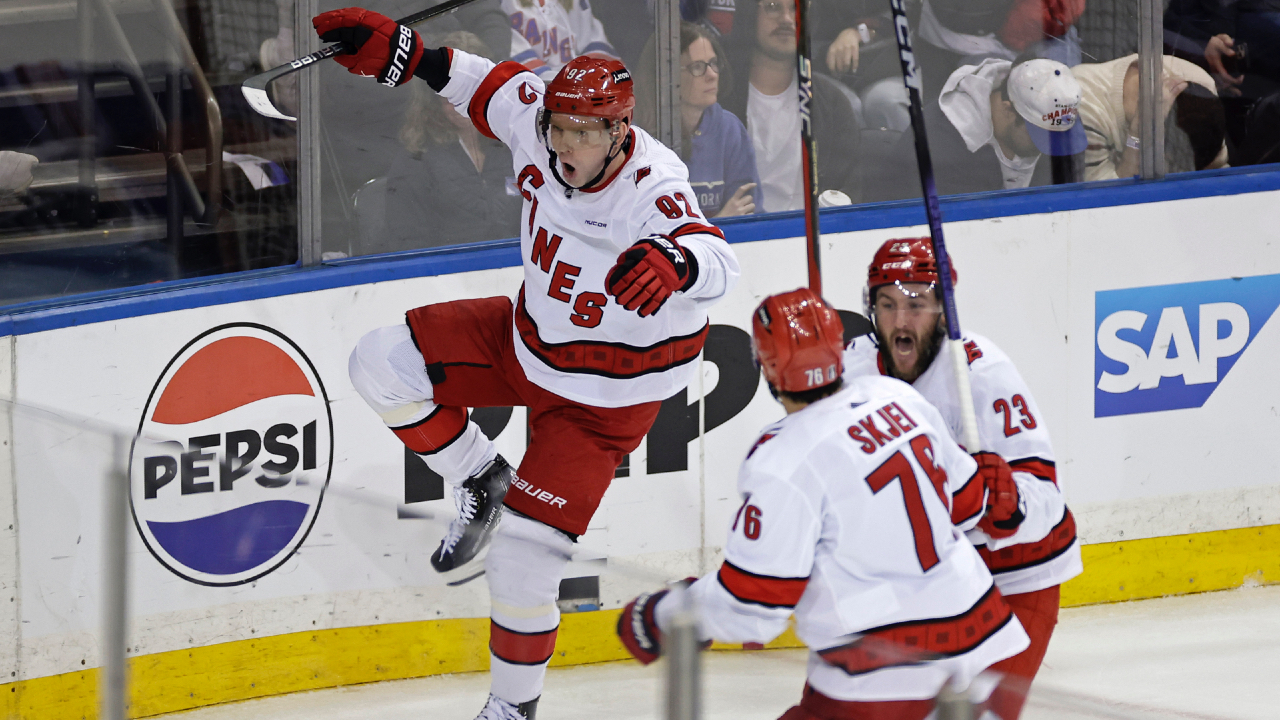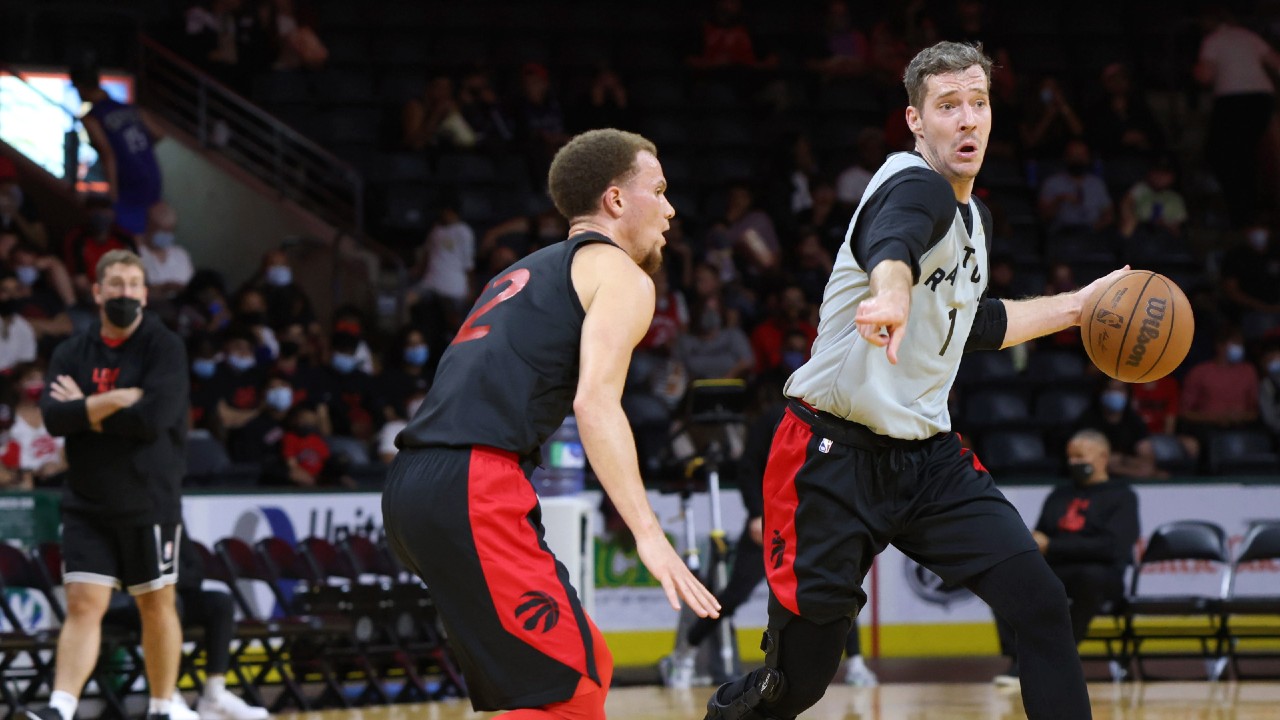
As a blustery winter week rolls on, there is, mercifully, a new season on the horizon: Transactions season.
The NBA trade deadline is Feb. 10. It’s significantly earlier than last year, when the schedule was amended due to the pandemic and Kyle Lowry said his non-goodbye goodbye before ultimately staying put a few more months (and just not playing). It leaves the Raptors in a position to make a decision on their direction with imperfect information — they’re right around .500, have six more games against East playoff teams in the next two weeks and don’t feel much closer to an ultimate all-in-or-step-back decision.
We’re in the heat of it now. Transactions rule, and so you’re well within your rights to be firing up your trade machine of choice. Before you do, though, we have to go through the drier part of the trade calendar: My annual deadline primer.
What follows is an explanation for the different assets the Raptors have available to them, the rules regarding trades under the collective bargaining agreement and other areas of clarification people have asked about, recently or historically. It’s also killjoy season.
Current Cap Sheet
The Toronto Raptors’ cap sheet looks the same as it did earlier in the year, when they waived Sam Dekker in a conservative luxury tax-avoidance move . While the Raptors added a number of players on emergency 10-day contracts due to a COVID outbreak on the roster, those deals did not count against the cap. Here’s how things look:
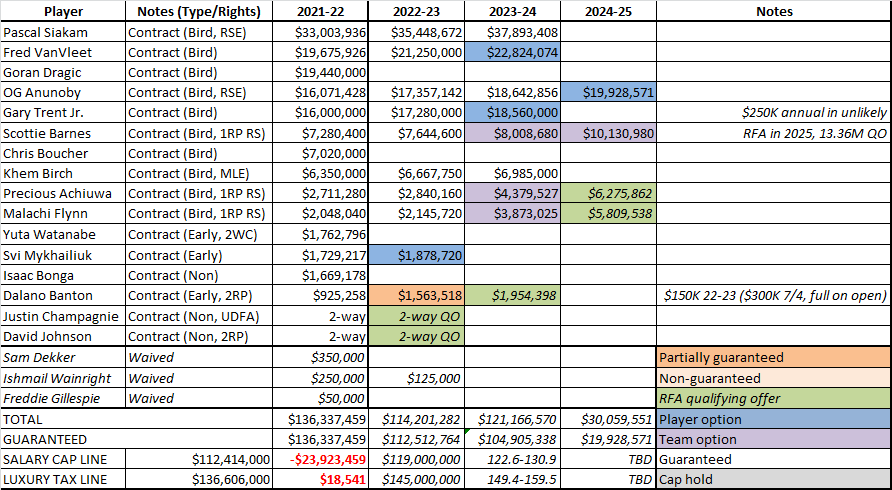
This snapshot is more useful to keep in mind longer-term, as the Raptors have already been operating as an above-cap team. Most notably, they currently project to be very light on cap space this coming summer, barring a major move before then. Don’t take that as a negative, necessarily — the Raptors have been a non-cap space team for years, and they’ll still have options like exceptions, trades and picks available to keep building.
The main takeaway there is that they might — and probably should — be open to taking on long-term salary in the right trade, because the opportunity cost of lost cap space is minimal. This is a change from the last few years when the Raptors had the option to create meaningful cap space, and flexibility was a larger priority at the deadline.
Luxury tax situation
Proximity to the luxury tax line is a much more important factor right now than next year’s cap sheet. In any trade, the Raptors will want to be salary-neutral, and probably prefer to take back less than they send out. Based on current estimates, the Raptors sit just $18,541 under the tax line. Even if Gary Trent Jr. misses some of his incentives, that’s tight enough that the Raptors have played most of the season with an empty roster spot.
I am aware some fans dislike talk of the tax and think teams should just pay it, if necessary. That’s true in some instances. The Raptors paid deep into the tax in their championship season. This isn’t a contention season, though, and it’s the third season in a row where the team’s revenues have been materially impacted by the pandemic. More importantly, league-wide tax projections for this season are extremely high. The luxury tax paid by tax teams is split between the non-tax paying teams, so getting beneath the tax not only cuts costs, it makes the Raptors eligible for a substantial payout at the end of the year. I estimated cutting Dekker could end up having a “real” impact of about $18 million, even though he was only earning $1.3 million.
It won’t be enough to simply have the trade work in the trade machine. Make sure the Raptors are taking back less money in any deal, or at least have it very close.
(As an aside, any post-deadline buyout with Goran Dragic will only reduce the team’s cap and tax liability by the amount he’s willing to leave on the table. You don’t clear the entire salary off the books in a buyout.)
Other tradable assets
In addition to players, the Raptors have some other trade assets available to them.
Cash: Teams can send and receive $5.79 million in total this league year. The Raptors haven’t touched those amounts yet, so they can sweeten a deal, or have one sweetened for them, with an OVO briefcase full of cash.
Draft picks: The Raptors have their full allotment of first-round picks, meaning they can trade any from 2022 all the way to 2028 (teams can only trade picks up to seven years out). League rules prohibit a team from trading consecutive future first-round picks, so the Raptors can’t deal all of them, but that’s seven firsts to choose from, with a max of up to four that can be dealt. The Raptors have traded away their 2022 (Malachi Richardson) and 2024 (Marc Gasol) second-round picks, leaving them 2023 and 2025-2028 to offer.
Player rights: The Raptors hold the draft rights to DeeAndre Hulett, a 2000 draft pick who never saw the NBA. These rights still hold value because NBA rules dictate that each side has to send something in any trade, and so outdated draft rights can work as a sort of currency. The Raptors also hold free-agent rights on Nando De Colo, Lucas Nogueira, Jason Thompson, Jeremy Lin and Jodie Meeks, but those rights are not eligible to be traded.
Trade restrictions
Every player on the Raptors is currently eligible to be traded.
Salary matching
The rules around trades change depending on the size of the trade and whether a team will be in the tax after a deal is done. For tax teams, it’s simple: You can take back 125 per cent of the salary you send out, plus $100,000. Teams beneath the tax operate under the following rules:

A more helpful way to look at this may be to examine different player combinations to see what amount could come back.
Keep in mind, I’ve separated “maximum allowable incoming salary” under the rules from the. That second number would need to be amended even lower for an imbalanced roster trade (two-for-one, three-for-two) by $432,000 for each additional roster spot opened up, as the Raptors would only be able to run below the roster minimum for two weeks before filling a spot (in other words, subtract about half a million for a new player if you’re sending out extra bodies in a deal).
Note that cash, player rights and draft picks do not count for salary matching. I picked one player with a large salary, one with a medium salary and one with a small salary for the purposes of illustration and no other reason whatsoever.
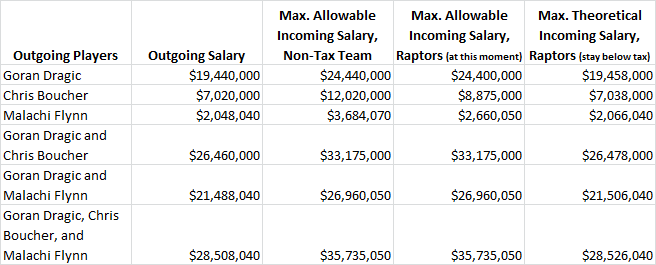
There is some wiggle room in how trades are structured so that each team involved can suit their own needs, so there is some flexibility around these numbers.
Exceptions
There are three exceptions teams can use to get around the salary matching rules in trades.
Disabled Player Exception: Teams can apply for one of these if they lose a player for the year. The Raptors don’t have one.
Minimum Player Exception: Teams are always permitted to acquire minimum-salary players so long as they have the roster space.
Traded Player Exception: A traded player exception allows a team to take back a salary that matches an existing exception, plus $100,000, without sending matching salary out. Because they can’t be combined with player salary or other exceptions, they’re not always the most useful accounting trick. Still, an option is an option, and the Raptors have two tiny exceptions ($1.57 million) from their deadline deals last year (Matt Thomas and Terence Davis) and a slightly larger one ($4.83 million) from the Kyle Lowry trade. The two mini-exceptions expire after the deadline, whereas the Lowry exception can be used into August.
Two-ways
Two-way contracts are allowed to be traded. They don’t count for salary matching and can’t create a trade exception, nor do they count against the cap or tax.
The NBA loosened the rules for two-way player availability over the course of the season, with one exception: If the Raptors want to use a two-way (say, Justin Champagnie) in the playoffs, they’ll need to convert him to a standard roster spot by the final day of the season, or negotiate a new multi-year deal with the player. The Raptors have a small chunk of their mid-level exception from this past summer remaining, which keeps open the option to sign Champagnie to a three-year deal rather than the usual two-year cap for minimum players.
There is no deadline for signing new two-way contracts this season, so the team could theoretically convert Champagnie and then sign a new two-way player into his old spot.
The TL;DR version
* The Raptors have multiple players, picks, and cash to send in deals.
* Their cap situation for next season and Michael Grange’s reporting suggests they may be willing to take on longer-term money.
* Shorter-term, any Raptors trade will likely be cap-neutral or save money under the tax.
*”Dragic and a first” allows the Raptors to bring back about $19.5 million in salary without going into the tax, barring any other moves.
*Watch for Champagnie to eventually get converted to a standard contract.
*The trade deadline is Feb. 10 at 3 p.m. ET.
We’ll be taking a look at some potential trades with Michael Grange and William Lou next week. You can always send me yours on Twitter, as well, though I make no promises about being gentle if they’re bad. Talking to you, JD Bunkis.


